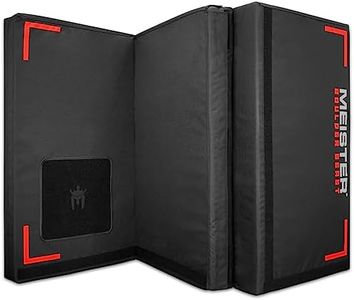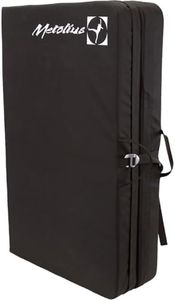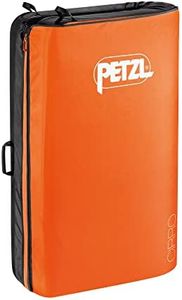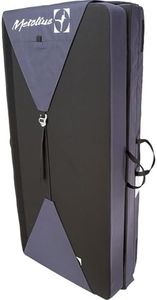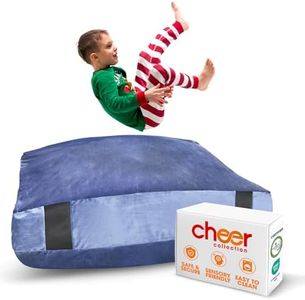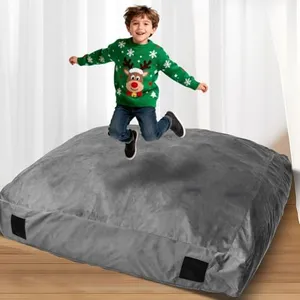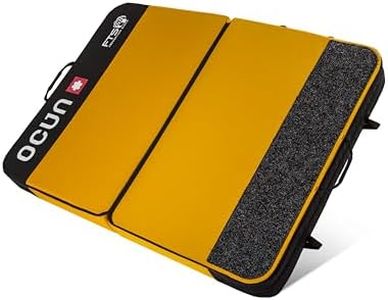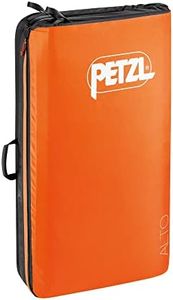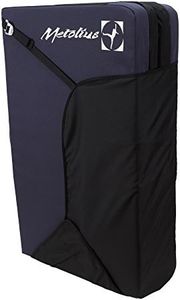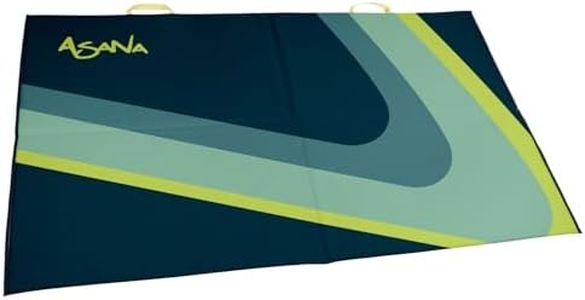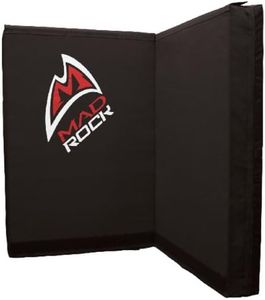10 Best Rock Climbing Crash Pads 2025 in the United States
Our technology thoroughly searches through the online shopping world, reviewing hundreds of sites. We then process and analyze this information, updating in real-time to bring you the latest top-rated products. This way, you always get the best and most current options available.

Our Top Picks
Winner
Meister Boulder Beast XL Tri-Fold Rock Climbing Crash Pad w/Backpack Straps - 72" x 44" x 5" - Black
Most important from
15 reviews
The Meister Boulder Beast XL Tri-Fold Rock Climbing Crash Pad is a well-designed option for rock climbers, offering a large surface area of 72” x 44” x 5” when unfolded. This impressive size makes it ideal for providing a safe landing spot for a variety of climbs, including short walls and highballs. The pad's four-layer construction combines both open and closed cell foam to offer superior cushioning, making falls less impactful and safer for climbers.
The integrated corner carpet square is a thoughtful feature, allowing climbers to clean their shoes before climbing, which helps maintain the pad's cleanliness and effectiveness. The crash pad is designed to be portable, with removable backpack straps and duffel-style handles for easy transportation. It folds down to a manageable size of 44” x 24” x 15” and weighs around 20 pounds, making it relatively easy to carry. The durability of this pad is another strong point, as it is covered in reinforced all-weather polyester, which can withstand harsh conditions.
Additionally, the large hook and loop fastening flaps allow multiple pads to be connected for an even larger landing area. The pad also includes multiple gear loops for attaching accessories, adding to its convenience. However, the pad's large size and weight might be a drawback for some users, particularly if they need to carry it over long distances. Its premium foam quality and extensive features come at a higher price point, which might not fit everyone's budget. This crash pad is best suited for serious climbers who prioritize safety, durability, and convenience in their gear.
Most important from
15 reviews
Metolius Basic Pad Black
The Metolius Basic Pad is a solid choice for beginner to intermediate climbers looking for a straightforward crash pad. It offers a decent size of 36 by 48 inches when open, providing enough coverage for many bouldering problems. The 4-inch thick sandwich foam gives good cushioning to absorb falls, which is important for safety. While the foam quality is standard—not premium—it is reliable for casual use.
Portability is handled well, with side handles and adjustable shoulder straps, making it easier to carry around the crag. However, it lacks pockets, so you won’t have extra storage for small gear or personal items. The closure system uses buckles that are simple and effective for keeping the pad folded securely during transport. In terms of durability, Metolius is a trusted brand, and the materials appear sturdy enough for regular outdoor use, though it might show wear faster if used intensively or on rough terrain.
The pad's size and weight (around 3.4 kg) strike a good balance for climbers who want protection without being overly bulky or heavy. It suits climbers who need a reliable, no-frills pad without extra features or premium foam layers. If you want something lightweight or with lots of storage, you may want to look further, but for basic safety and comfort, this pad does the job well.
PETZL CIRRO Crashpad - Folding Foam Crashpad for Bouldering
Most important from
7 reviews
The PETZL CIRRO Crashpad offers a good balance of protection and portability, making it suitable for boulderers who want a reliable mat without too much bulk. Its size (148 x 118 cm) and thickness (12.5 cm) provide a decent landing area and cushioning, supported by its triple-density foam layers that combine different foam types for effective shock absorption. The one-piece hingeless design means the entire surface cushions evenly, which is a plus for safety and comfort compared to foldable pads that can have gaps or uneven spots.
In terms of portability, the CIRRO is designed with multiple handles and adjustable shoulder, waist, and chest straps, making it easier to carry around rough terrain. The inclusion of a bandolier strap helps quickly move between bouldering spots, though it weighs about 9.4 kg (around 20.7 lbs), which might feel a bit heavy for longer hikes or users with less strength.
Durability is well addressed through the use of waterproof, ballistic Cordura fabric, reinforced corners, and protected seams, so it should hold up well against rough ground and frequent use. While it doesn’t have a traditional closure system like buckles or zippers—relying instead on its folding design and straps—it stays compact and secure when closed. This crash pad suits climbers who prioritize a blend of protection and transportability, especially in moderate to challenging terrain. However, its weight may be a consideration for those seeking the lightest option possible. The cushioning and build quality make it a solid choice for both beginners and more experienced boulderers needing a dependable crashpad.
